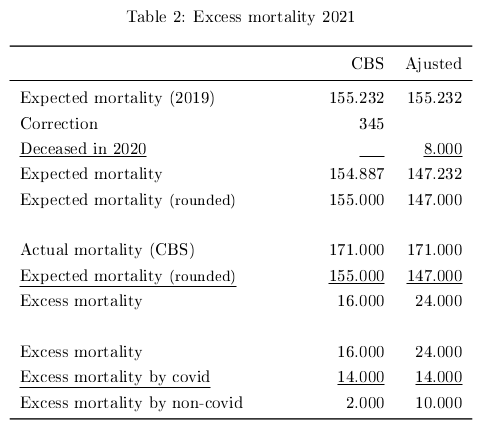Hans Lugtigheid
Abstract
This article show how excess mortality by the CBS possibly is underestimated.
We correct the expected mortality with the estimated number of people who died in earlier years than expected because of the pandemic. For 2021 this correction is 8K. Then the excess mortality increases from 16K (CBS) to 24K.
There also are people who died by covid in, say, April, who without the pandemic would have died later in the same year, say October. With this effect total excess mortality rises with 6K to 30K.
Excess mortality is divided in covid and non-covid. De large increase in non-covid deaths is striking.
The analysis supports the conjecture that excess mortality is underestimated.
Note: This is the short version. The full version has more backgrounds and explanations.
The excess mortality is strongly underestimated
Note: The numbers in this article are for the Netherlands. For you own country use the appropriate numbers.
Introduction
With the pandemic excess mortality has become a matter of interest. The main starting point is that there must be concurrence on the numbers. This is not always the case. I give some examples with the numbers from the CBS (Dutch Central Bureau of Statistics). I use estimates in those calculations.
At the end with conclusions and recommendations.
In my main article I elaborate more on estimates, manner of calculation etcetera (Lugtigheid, 2023d).
Excess mortality and expected mortality
Excess mortality per year is actual mortality minus expected mortality.
Many older people who died in 2020 from covid would have died in 2021 without the pandemic. Their number can be estimated at January first of 2021. Hence we have to lower the expected mortality for 2021 by that number. And so on for subsequent years.
A person dies from covid in, say, April. Without the pandemic that person would have died in, say, October. Then for the whole year this death does not count as excess mortality in the usual definition. This I call excess mortality within the year.
Mortality in 2020
In 2019 the CBS estimated the expected mortality for 2020 at 153.402 (CBS, 2019). In 2020 year 168.678 people died (CBS, n.d.-b). This was 15 thousand more than expected.
In 2020 20.661, rounded 21 thousand, people died from covid (CBS, 2022). I estimate that without the pandemic seven thousand of those also would have died in 2020. This is excess mortality in the year. Then the annual year on year excess mortality from covid in 2020 is 14 thousand. With excess mortality of 15 thousand excess mortality from other causes in 2020 is one thousand.
Suppose one thousand people have died from other causes earlier in the year than expected. This could pertain to older people who where not allowed to have visitors and therefore suffered psychological harm and died earlier. Then the total excess mortality in 2020 becomes 23 thousand (15+7+1). See table 1.

Mortality in 2021
In 2019 the CBS estimates the mortality for 2021 to be 155.232. (CBS, 2019). In 2020 the CBS adjusted this to 154.887 (CBS, 2023a).
In 2020 21 thousand people died from covid. I estimate that from these eight thousand people would have died in 2021 without the pandemic. I decrease the expected mortality of 154.887 with eight thousand to 146.887 thousand. I round these numbers.
I assume one disturbing factor – covid. Then the estimates should be around equal. A possible explanation for the difference is the following. The expected mortality is recalculated with a historically based percentage. This percentage is volume related. However covid hits the weak the hardest. Then the distribution of the people in the remaining group changes. And then the percentage for recalculation has to be adjusted accordingly. See for more Lugtigheid, 2023a.
In 2021 around 171 thousand people died (CBS, z.d.-a). The excess mortality comes to 16 thousand (CBS) and 24 thousand.
In 2021 19 thousand people died from covid (CBS, 2022). I estimate that from these five thousand people would have died also in 2021 without covid. Then the excess mortality due to covid is 14 thousand. The excess mortality by other causes than covid becomes two thousand and ten thousand. See table 2 for an overview.

In 2021 the adjusted excess mortality on an annual base was 24 thousand. I estimate that in 2021 five thousand people died early by covid who, without the pandemic, would have died later in the year. This is excess mortality in the year. There were also people who died early by other causes than covid but would otherwise have died later that year. This might for example be because of postponed medical treatment. How many is difficult to estimate. For this paper I assume their number to be one thousand. Then the total excess mortality in 2021 equals 30 thousand people (24+5+1). Or, otherwise calculated, 19 thousand people died prematurely from covid and eleven thousand from other causes. See table 3.

Calculations like these can and must be made for 2022 and later years.
Conclusion
When we consider the above effects we see that total excess mortality in 2021 gets much higher than with the CBS. This gives a better view of the damage done by covid.
The strong increase of mortality from non-covid is striking.
It is recommended to develop methods to better estimate the relevant quantities.
Literature
CBS (z.d.-a). Vragen en antwoorden over de sterftecijfers. https://www.cbs.nl/nl-nl/faq/corona/medisch/vragen-en-antwoorden-over-de-sterftecijfers
CBS (z.d.-b). Sterfte-Overledenen-Toon tabel. https://www.cbs.nl/nl-nl/visualisaties/dashboard-bevolking/bevolkingsgroei/overlijden
CBS (2019, 16 december). Prognose bevolking; kerncijfers, 2019-2060. https://www.cbs.nl/nl-nl/cijfers/detail/84645NED
Centraal Bureau voor de Statistiek. (2022, 23 juni). 3.4.4.1 Overledenen, verwacht, minus COVID-19, oversterfte en COVID-19-sterfte; Totaal, Wlz-zorggebruik, leeftijd, per oversterftegolf en jaar https://www.cbs.nl/nl-nl/longread/rapportages/2022/sterfte-en-oversterfte-in-2020-en-2021/3-beschrijving–over–sterfte-en-doodsoorzaken-in-2020-en-2021
CBS (2023a, april) Oversterfte en verwachte sterfte https://www.cbs.nl/nl-nl/nieuws/2023/04/2022-derde-jaar-op-rij-met-oversterfte/oversterfte-en-verwachte-sterfte
CBS (2023b 25 april ). In 2022 veel minder mensen aan COVID-19 overleden dan in 2020 en 2021.https://www.cbs.nl/nl-nl/nieuws/2023/17/in-2022-veel-minder-mensen-aan-covid-19-overleden-dan-in-2020-en-2021
Lugtigheid, Hans. (2023a, september) Verwachte sterfte: correctie percntage met gewijzigde distributie https://www.hanslugtigheid.nl/expected-mortality-adjusted-for-distribution
Lugtigheid, Hans. (2023b, september) Verwachte sterfte: test https://www.hanslugtigheid.nl/expected-mortality-test
Lugtigheid, Hans. (2023c, september) Expected mortality is strongly underestimated https://www.hanslugtigheid.nl/excess-mortality-is-strongly-underestimated
© 2023. This work is licensed under a CC BY 4.0 license